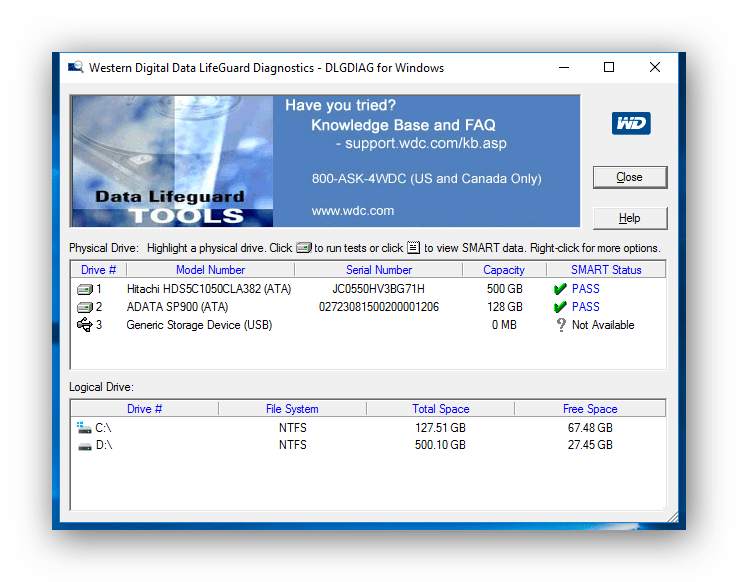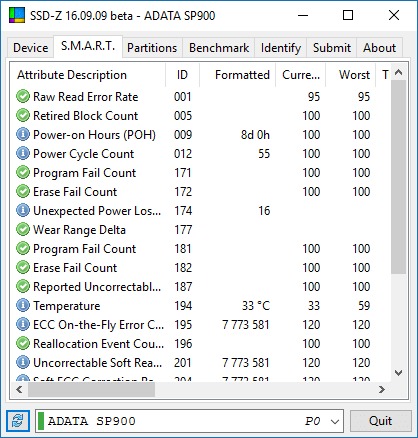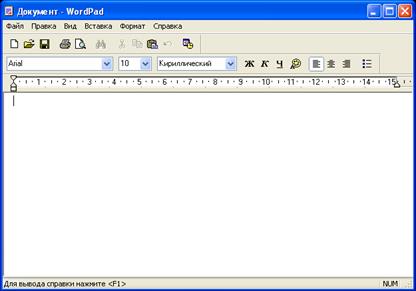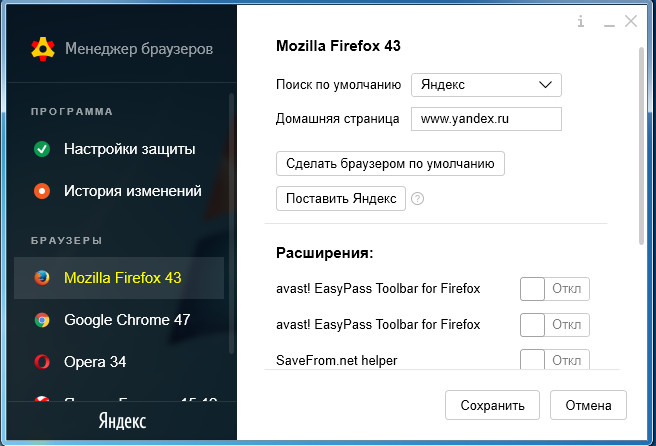If you decide to purchase a solid-state SSD drive, there may be several reasons for this:
- You are not happy with the speed of your HDD.
- You need fast windows and certain types of applications, games.
However, installing an SSD in a computer or laptop, and then filling it with information is not enough. You must also optimize its work with the work of your OC.
Consider the basic methods for optimizing an SSD drive.
AHCI SATA
Technology that allows you to use the TRIM function for various solid state drives. Its inclusion is made at the BIOS level of your PC or laptop.
Enabling AHCI SATA:
- Open the command line with the key combination win + R.
- Enter the command: "regedit" (access to the registry).
- Go to the following path: HKEY_LOCAL_MACHINE → SYSTEM → CurrentControlSet → Services → storahci.
- Change the value of the ErrorControl subkey to 0 (the default is 3) by calling the context menu and clicking the “Modify” parameter.
- Go to the branch with the name "StartOverride" and change its value to 0 (default is 3).
- Reboot your PC (laptop), go to BIOS / UEFI (how to go into BIOS, see separately for the model of your laptop or PC motherboard). In the "storage configuration" section and in the "SATA port" subsection, set AHCI or in the "SATA RAID / AHCI Mode" section, set AHCI (For different BIOS versions, your own partitions and subsections).
- Check the functionality of the function in Windows. Go to the following path: Control Panel → Device Manager → IDE ATA / ATAPI controllers. In the last subsection, the device should appear: “Standard SATA AHCI Controller”.
TRIM function
By default, this function is enabled on windows 7 and above, however, it is better to manually check whether this function works. The meaning of TRIM is that after deleting files, windows transfers information to the SSD drive that a certain area of \u200b\u200bthe disk is not used and can be cleared for recording. (Data remains in the HDD and recording is performed “over” the existing one). Over time, if the function is disabled, there will be a drop in drive performance.
Checking TRIM on Windows:
- Launch the command line by pressing the key combination win + R.
- Enter the command: "fsutil behavior query disabledeletenotify".
- If after entering the message “DisableDeleteNotify \u003d 0” is displayed, then the TRIM function is enabled, if “DisableDeleteNotify \u003d 1”, then TRIM does not function. If TRIM does not work, enter the command: “fsutil behavior set DisableDeleteNotify 0,” then repeat steps 2 and 3.
Defragmentation
This feature helps optimize and speed up the operation of the HDD, but for SSDs, it has a detrimental effect. For SSDs, the Auto Defrag function is disabled by default. To check if it works:
- Press the combination win + R.
- In the command prompt window, enter the command: “dfrgui” and click “OK”.
- In the window that opens, highlight your SSD and look at the "Scheduled Optimization" item. For our solid state drive, it must be disabled.
Indexing
A Windows feature that helps you quickly search for files on a disk with large amounts of information, however, increasing the load on writing to an SSD. To disable it:
- We pass to the section "This Computer", "My Computer", "Computer" (for each OS differently).
- Choose your SSD and select “Properties” in the context menu.
- In the window that opens, uncheck the box next to the option: "Allow indexing the contents of files on this disk in addition to the file properties."
Search service
Its function creates a file index, thanks to which finding a variety of files and folders is faster. However, the speed of the SSD is quite enough to abandon it. To disable it, you must:
- Go to the following address: Control Panel → System and Security → Administrative Tools → Computer Management.
- Go to the tab: "Services".
- Find the “Windows search” service and select “Disabled” in the “Launch Type” tab.
Hibernation
A mode that allows you to save the contents of RAM on your hard drive, so when you turn it on next time, information and open applications from the previous session are saved.
When using the SSD, the meaning of this function is lost, since the drive starts up so quickly. And "Hibernation", creating a cycle of "write-overwrite", reduces the life of the SSD drive.
Disable hibernation:
- Run cmd.exe again with the win + R key combination.
- Enter the command: "powercfg -h off".
Write caching
This feature improves the performance of your solid state drive. When it is turned on, NCQ write and read technology is used. NCQ - accepts several requests at the same time, and then organizes their execution order in such a way as to achieve maximum performance.
To connect you need:
- Call command line with win + R
- Enter the command: "devmgmt.msc".
- Open "Disk Devices", select SSD and select "Properties" in the context menu.
- Go to the "Policy" tab.
- Check the box next to the option: “Allow caching of records for this device”.
Prefetch and Superfetch
Prefetch - a technology by which frequently used programs are loaded into memory in advance, thereby accelerating their subsequent launch. At the same time, a file of the same name is created on disk space.
Superfetch - A technology similar to Prefetch with the difference that the PC foresees which applications will be launched by loading them into memory in advance.
Both functions are not useful when using SSD. Therefore, it is best to disable them. For this:
- We invoke the command line with the key combination win + R.
- We execute the command: "regedit" (go to the registry).
- Follow the path: HKEY_LOCAL_MACHINE → SYSTEM → CurrentControlSet → Control → Session Manager → Memory Management → PrefetchParameters.
- Find several parameters in the registry subkey: “EnablePrefetcher” and “EnableSuperfetch”, set their value to 0 (default 3).
SSD Mini Tweaker Utility
All of the above actions can be performed manually, but the programmers created programs - tweakers, the purpose of which is to customize the windows OS, as well as its individual components with a few clicks. One such program is the SSD Mini Tweaker.
SSD Mini Tweaker - A program, a kind of tweakers, which allows you to optimize your SSD without much effort.
Benefits:
- Full Russification.
- Works on all OSs starting with Windows 7.
- Free
- Intuitive interface.
- No installation required.
other methods
Such manipulations as transferring the browser cache, swap files, Windows temporary folders, backing up the system from an SSD to HDD (or disabling this feature) are useless, since they increase the life of the SSD but limit the potential for its use.
Thus, having performed the above simple manipulations with your OS, you can extend the life of your drive, as well as configure it for maximum performance.
In this article, you will learn how to find out the basic characteristics of solid state drives, as well as how to test them. For this operation, we took the SSD-Z utility, which we will review today. It is free and has useful features in its arsenal. You can immediately download it from here.
When you first start the program, many users will immediately say that it is similar to or other similar utilities, yes it is, so it will be easier for them to understand it.
Tab Device all disk information is shown. Now I will explain for each item presented, this is for those who do not know English.
- Device name - name of the solid state drive;
- Firmware -;
- Serial Number - serial number;
- Controller - the controller that is used in the disk;
- Technology - production technology;
- Сells - type of used memory cells;
- Launch Date - date of creation of the drive;
- TRIM - Availability;
- Capabilities - technologies supported in SSD;
- Interface - the interface through which the disk is connected;
- SMART - disk status;
- Temperature - current disk temperature;
- POH - operating time;
- Capacity - disk capacity;
- Bytes Written - written bytes;
- Volumes - drive letter;
- Partitions - type of sections ();
- Sector Size - the size of one sector.
It is interesting:
As you can see, there are a lot of parameters and this is only on one tab. All information is important and may be useful in some situations. Of course, if the model of your drive is present in the utility database, then information will certainly be found. Unfortunately, you won’t be able to recognize information about the newly released disc. Although there are utilities that take information from the system and other sources for absolutely any drives.
Check SSD Status
I already wrote an article about how this program has a similar function and it is called S.M.A.R.T. I'll write about this technology, so stay tuned for updates to the site.

In this section you will find information on read errors, disk uptime, temperature, and other useful information. Of course, when using the utility you will get much more information.
When going to the tab Partitions we get data about partitions and disks existing on the computer. To select another disk, select it at the bottom of the program.

SSD Speed \u200b\u200bTesting
The SSD-Z utility also has the function of testing the speed of SSD. It is located on the tab Benchmark. Since the program is still raw, it is better not to wait on the results of objective information.

The remaining tabs do not carry particularly useful information. I think the program is not bad and there is still room for improvement. It would not be bad if all the functions were organized in the best possible way and assembled in one place so as not to use several programs.
June 19, 2010 at 13:03How I ditched SSD in two months
- Computer hardware
Epigraph
“Never trust a computer that you cannot throw out of a window”
Steve Wozniak
Two months ago I installed an SSD drive in my laptop. He worked great, but last week he suddenly died due to depletion of cells (as I believe). This article is about how this happened and what I did wrong.
Description of the environment
- User: Web developer. That is, things like virtual machines, eclipse, frequent updates of repositories are in use.
- OS: Gentoo. That is, the world is often "rebuilt."
- FS: ext4. That is, a journal is being written.
So, the story begins in April, when, finally, I got a hand to copy the sections on the 64GB SSD broom, bought back in September. I deliberately do not inform the manufacturer and the model, because while I have not yet figured out what happened, it does not really matter.
What have I done to make it work longer
Of course, I studied numerous publications on how to protect SSDs. And here is what I did:- Put noatime for partitions, so that when accessing the file, the record about the last access time is not updated.
- Increased the RAM to the maximum and disabled the swap.
S.M.A.R.T.
Three days before the fall, I became preoccupied with the question: how can I find out if I have enough happiness? I tried the utility smartmontoolsbut she was displaying incorrect information. I had to download the datasheet and write a patch for them.After writing the patch, I dig one interesting parameter: average_number_of erasures / maximum_number_ of erasures \u003d 35000/45000. But after reading that the MLC cells withstand only 10,000 cycles, I decided that these parameters do not mean exactly what I think and scored on them.
Chronicle of the fall
Suddenly, inexplicable things began to happen during work, for example, new programs did not start. For the sake of interest I looked at the very S.M.A.R.T. parameter, it was already 37000/50000 (+2000/5000 for three days). It was already not possible to restart, the file system of the main partition was not read.I started from the compact and started checking. Check showed a lot of broken nodes. During the repair process, the utility began testing for bad sectors and marking them. It all ended the next day with the following result: 60GB of 64GB were marked as bad.
Note: In SSD hard drives, a cell is considered a bat if new information cannot be written there. Reading from such a cell will still be possible. On this aly run utility badblocks in read-only mode, it is unlikely that she will find anything.
I decided to start the flashing utility, because it not only reflashes, but also reformatted the disk. The utility began to format, groaned and showed that a reasonable allowable number of bad sectors had been exceeded, and also that there were failures, so it was not possible to complete the formatting.
After that, the disk began to be defined as a disk with a very strange name, model number and size of 4GB. And, in the future, except for specialized utilities, no one sees it.
I wrote a letter in support of the manufacturer. They recommended me to reflash, if it does not work out, then return it to the seller. Warranty 2 more years, so I’ll try.
I end this section with thanks to Steve Wozniak, who taught me how to make periodic backups.
What happened
Honestly, I myself do not know. I assume the following: S.M.A.R.T. I didn’t lie and the cells really wore out (this indirectly confirms the backup that I did two days before the fall, when unpacking it showed that the creation dates of some files were reset). And when checking for sector troubles, the disk controller simply allowed to mark all cells as broken, in which the permissible number of write cycles was exceeded.What to do if you have an SSD
Windows
Put Windows 7 in it as much as possible optimized for such drives. Also put a lot of RAM.Macos
Most likely, only those computers that will be immediately sold with SSDs are optimized.Freebsd
Put 9.0. Read Linux tips, think about what you can make of them.Linux
- Install the 2.6.33 kernel, in which there is optimization for such disks in the form of the TRIM command.
- Increase memory so that you can safely disable the swap.
- Set for mounted partitions noatime.
- Used a file system made on the principle of copy-on-write or a non-journaled file system (for example ext2).
Currently, copy-on-write FS is rather difficult to use. ZFS so far only works through FUSE. But nilfs and btrfs, when mounting, swear that their format is not finally finalized yet.
- Enable NOOP IO Scheduler, it will allow you to not perform unnecessary useless actions for SSD.
- Conceptually true, but not much help to the drive - transferring temporary files to tmpfs.
- For systems that write intensively to the log, you need to store it in another place. This is mainly true for servers for which the log server is raised without problems.
- Get S.M.A.R.T.-utilities that correctly display the status of the SSD, so that you can periodically monitor the drive.
- Just spare the drive. And for gentushniks, this additionally means not "reassembling the world."
Questions to the habrasociety
- Is it really possible to kill MLC cells in 2 months? Of course, I understand that I did not spare the disc, but I did not do anything supernatural, it just worked as usual.
- Is this a warranty case?
UPD: I had a drive Transcend TS64GSSD25S-M.
UPD2: In the comments, very good reviews about Intel SSDs and SAMSUNG. In addition, people wonder how you can kill an SSD broom so quickly. Believe me, I was perplexed in the same way. Nevertheless, it is possible that this is a hastily tailored SSD series and can be quickly killed.
UPD3: In the comments and
During operation of any drive, various kinds of errors may appear over time. If some can simply interfere with the work, then others are even able to disable the drive. That is why it is recommended to periodically scan disks. This will allow not only to identify and fix problems, but also to copy the necessary data on a reliable medium in time.
So, today we’ll talk about how to check your SSD for errors. Since we cannot physically do this, we will use special utilities that will diagnose the drive.
Method 1: Using CrystalDiskInfo Utility
To test the disk for errors, we will use a free program. It is quite easy to use and at the same time fully displays information about the status of all disks in the system. It is enough to just launch the application, and we will immediately receive all the necessary data.

In addition to collecting information about the drive, the application will conduct an S.M.A.R.T analysis, which can be used to judge the performance of the SSD. All in all, in this analysis there are about two dozen indicators. CrystalDiskInfo displays the current value, the worst and the threshold of each indicator. Moreover, the latter means the minimum value of the attribute (or indicator) at which the disk can be considered faulty. For example, take an indicator such as “Remaining SSD Resource”. In our case, the current and worst value is 99 units, and its threshold is 10. Accordingly, when the threshold value is reached, it is time to look for a replacement for your solid state drive.

If CrystalDiskInfo detected erasure errors, software errors, or crashes during disk analysis, then you should also consider the reliability of your SSD.

Based on the test results, the utility also evaluates the technical condition of the disk. Moreover, the assessment is expressed both in percentage terms and in quality. So, if CrystalDiskInfo rated your drive as "Good", then there’s nothing to worry about, but if you see an estimate "Anxiety", then in the near future we should expect the SSD to fail.

Method 2: using the SSDLife utility
SSDLife is another tool that allows you to evaluate the health of a disk, the presence of errors, and also conduct an S.M.A.R.T analysis. The program has a simple interface, so even a beginner can figure it out.

Like the previous utility, SSDLife immediately after launch will conduct an express disk check and display all the basic data. Thus, to check the drive for errors, you just need to run the application.
The program window can be divided into four areas. First of all, we will be interested in the upper area, where the status of the disk is displayed, as well as the approximate life.

The second area contains information about the disk, as well as an estimate of the state of the disk in percentage terms.

If you want to get more detailed information about the state of the drive, then click "S.M.A.R.T." and get the results of the analysis.

The third area is disk sharing information. Here you can see how much data has been written or read. These data are for informational purposes only.
And finally, the fourth area is the application control panel. Through this panel, you can access the settings, help information, and also restart the scan.

Method 3: Using the Data Lifeguard Diagnostic Utility
Another testing tool is the development of Western Digital, called Data Lifeguard Diagnostic. This tool supports not only WD drives, but also other manufacturers.

Immediately after launch, does the application diagnose all the drives that are in the system? and displays the result in a small table. Unlike the above tools, this one only displays a status estimate.
For a more detailed scan, just double-click the left mouse button on the line with the desired drive, select the desired test (quick or detailed) and wait for the end.

Then by clicking on the button VIEW TEST RESULT? You can see the results, where a brief information about the device and an assessment of the status will be displayed.

Conclusion
Thus, if you decide to diagnose your SSD drive, then at your service there are quite a lot of tools. In addition to those discussed here, there are also those who will be able to analyze the drive and report on existing errors.
HDDScan
The program is designed to check hard drives and SSDs for bad sectors, view S.M.A.R.T. attributes, changes to special settings, such as: power management, start / stop of the spindle, adjustment of the acoustic mode, etc. It is possible to output the temperature of the drive to the taskbar.
Features and requirements
Supported drive types:- HDD with ATA / SATA interface.
- HDD with SCSI interface.
- USB HDD (see Appendix A).
- HDD with FireWire or IEEE 1394 interface (see Appendix A).
- RAID arrays with ATA / SATA / SCSI interface (tests only).
- USB flash drives (tests only).
- SSD with ATA / SATA interface.
- Test in linear verification mode.
- Test in linear reading mode.
- Test in linear recording mode.
- Butterfly reading test (artificial random reading test)
- Reading and analysis S.M.A.R.T. parameters from disks with the ATA / SATA / USB / FireWire interface.
- Reading and analyzing log tables from SCSI drives.
- Launch S.M.A.R.T. tests on drives with ATA / SATA / USB / FireWire interface.
- Temperature monitor on drives with ATA / SATA / USB / FireWire / SCSI interface.
- Reading and analysis of identification information from ATA / SATA / USB / FireWire / SCSI drives.
- Changing AAM, APM, PM parameters on ATA / SATA / USB / FireWire drives.
- View defect information on a SCSI drive.
- Spindle start / stop on ATA / SATA / USB / FireWire / SCSI drives.
- Saving reports in MHT format.
- Printing reports.
- Support for "skins".
- Command line support.
- Support for SSD drives.
- Operating System: Windows XP SP3, Windows Server 2003, Windows Vista, Windows 7, Windows 8, Windows 10 (NEW).
- The program should not be launched from a drive that is in read-only mode.
User interface
The main view of the program at startup
Fig. 1 Main view of the program
Main window controls:
- Select Drive - a drop-down list that contains all the supported drives in the system. The drive model and serial number are displayed. Nearby is an icon identifying the alleged type of drive.
- S.M.A.R.T. Button - allows you to get a report on the status of the drive, made on the basis of the attributes S.M.A.R.T.
- TESTS button - shows a pop-up menu with a choice of read and write tests (see. Fig. 2).
- TOOLS button - shows a pop-up menu for selecting available controls and disk functions (see Fig. 3).
- Button More - shows a drop-down menu with program controls.
When you press the TESTS button, a pop-up menu offers you one of the tests. If you select a test, the test dialog box will open (see Figure 4).
Fig. 2 Test menu

When you press the TOOLS button, a pop-up menu will prompt you to select one of the following options:
Fig. 3 Function Menu

- DRIVE ID - Generates an identity information report.
- FEATURES - opens a window of additional features of the program.
- S.M.A.R.T. TEST - opens the window S.M.A.R.T. tests: Short, Extended, Conveyance.
- TEMP MON - launches a temperature monitoring task.
- COMMAND - opens a command line build window.
Test Dialog Box
Fig. 4 Test dialog

Controls:
- FIRST SECTOR field - initial logical sector number for testing.
- SIZE field - the number of logical sector numbers for testing.
- BLOCK SIZE field - block size in sectors for testing.
- Button Previous - returns to the main program window.
- Next button - adds a test to the task queue.
- Only one surface test can be run at a time. This is due to the fact that the author of the program has not yet been able to obtain stable qualitative results when running 2 or more tests at the same time (on different drives).
- A test in Verify mode may have a block size limit of 256, 16384, or 65536 sectors. This is due to the features of Windows.
- Test in Verify mode may not work correctly on USB / Flash drives.
- When testing in Verify mode, the drive reads the data block into the internal buffer and checks its integrity; data transfer via the interface does not occur. The program measures the drive ready time after performing this operation after each block and displays the results. Blocks are tested sequentially - from minimum to maximum.
- When testing in Read mode, the drive reads data into the internal buffer, after which the data is transmitted via the interface and stored in the program’s temporary buffer. The program measures the total readiness of the drive and data transfer after each block and displays the results. Blocks are tested sequentially - from minimum to maximum.
- When testing in Erase mode, the program prepares a block of data filled with a special pattern with a sector number and transfers data to the drive, the drive writes the received block ( information in the block is irretrievably lost!) The program measures the total transmission and recording time of the block and the readiness of the drive after each block and displays the results. Blocks are tested sequentially - from minimum to maximum.
- Testing in Butterfly Read mode is similar to testing in Read mode. The difference lies in the order in which the blocks are tested. Blocks are processed in pairs. The first block in the first pair will be Block 0. The second block in the first pair will be Block N, where N is the last block of a given section. The next pair will be Block 1, Block N-1, etc. Testing ends in the middle of a given section. This test measures reading time and positioning.
Task management window
Fig. 5 Task Manager

This window contains the task queue. This includes all the tests that the program launches, as well as the temperature monitor. The manager allows you to remove tests from the queue. Some tasks can be paused or stopped.
Double-clicking on the entries in the queue brings up a window with information about the current task.
Tests info window
The window contains information about the test, allows you to pause or stop the test, and also generates a report.
Graph Tab:
It contains information on the dependence of the test speed on the block number, which is presented in the form of a graph.
Fig. 6 Graph Tab

Map Tab:
It contains information about the dependence of testing time on the block number, which is presented in the form of a map.
Fig. 7 Map Tab

You can select “Block Processing Time” in milliseconds. Each tested block that takes longer than “Block Processing Time” will be logged on the “Report” tab.
Report Tab:
Contains information about the test and all blocks whose testing time is longer than the "Block Processing Time".
Fig. 8 Report Tab
Identification information
The report contains information about the main physical and logical parameters of the drive.
The report can be printed and saved to an MHT file.
Fig. 9 Example identity window

S.M.A.R.T. report
The report contains information about the performance and “health” of the drive in the form of attributes. If, according to the program, the attribute is normal, then the green icon is next to it. Yellow indicates the attributes that you should pay particular attention to, as a rule, they indicate any malfunction of the drive. Red indicates attributes that are outside the normal range.
Reports can be printed or saved to a file of type MHT.
Fig. 10 Sample Report S.M.A.R.T.

Temperature monitor
Allows you to estimate the temperature of the drive. Information is displayed in the taskbar, as well as in a special window for information about the test. Fig. 11 contains readings for two drives.
Fig. 11 Taskbar temperature monitor

For ATA / SATA / USB / FireWire drives, the information window contains 2 values. The second value is displayed in the taskbar.
The first value is taken from the Airflow Temperature attribute, the second value is taken from the HDA Temperature attribute.
Fig. 12 Temperature monitor for ATA / SATA drive

For SCSI drives, the information window contains 2 values. The second value is displayed in the taskbar.
The first value contains the maximum allowable temperature for the drive, the second shows the current temperature.
Fig. 13 Temperature Monitor for SCSI Disk

S.M.A.R.T. tests
The program allows you to run three types of S.M.A.R.T. tests:
- Short test - usually lasts 1-2 minutes. Checks the main nodes of the drive, and also scans a small portion of the drive surface and sectors located in the Pending-List (sectors that may contain read errors). The test is recommended for a quick assessment of the state of the drive.
- Extended test - usually lasts from 0.5 to 60 hours. Checks the main components of the drive, and also completely scans the surface of the drive.
- Conveyance test - usually lasts a few minutes. Checks the nodes and logs of the drive, which may indicate improper storage or transportation of the drive.
The SMART test can be selected from the SMART Tests dialog box, called up by pressing the SMART TESTS button.
Fig. 14 SMART Tests Dialog Box

Once selected, the test will be added to the Tasks queue. Information window S.M.A.R.T. The test can display the status of the completion and completion of the task.
Fig. 15 Information window S.M.A.R.T. test

Additional features
For ATA / SATA / USB / FireWire drives, the program allows you to change some parameters.
- AAM - function controls the noise of the drive. Enabling this function allows you to reduce drive noise due to smoother head positioning. At the same time, the drive loses a little in performance with random access.
- APM - the function allows saving drive power by temporarily reducing the rotation speed (or complete stop) of the drive spindle at the time of inactivity.
- PM - the function allows you to set the spindle stop timer for a specific time. When this is achieved, the spindle will be stopped, provided that the drive is in idle mode. Any program accessing the drive causes the spindle to spin up and reset the timer to zero.
- The program also allows you to stop or start the drive spindle forcibly. Accessing the drive by any program forces the spindle to spin up.
Fig. 16 Information window for additional features of ATA / SATA drive

For SCSI drives, the program allows you to view defect lists and start / stop the spindle.
Fig. 17 Information window for additional SCSI drive capabilities

Command line usage
The program can build a command line to control some parameters of the drive and save this line in a .bat or .cmd file. When such a file is launched, the program is called in the background, changes the drive parameters in accordance with the settings and automatically closes.
Fig. 18 Command line build window

Appendix A: USB / FireWire Drives
If the drive is supported by the program, then tests are available for it, S.M.A.R.T. features and additional features.
If the drive is not supported by the program, then only tests are available for it.
USB / FireWire Drives Supported by the Program:
| Storage device | Controller chip |
| StarTeck IDECase35U2 | Cypress CY7C68001 |
| Wd passpopt | Unknown |
| Iomega PB-10391 | Unknown |
| Seagate ST9000U2 (PN: 9W3638-556) | Cypress CY7C68300B |
| Seagate External Drive (PN: 9W286D) | Cypress CY7C68300B |
| Seagate FreeAgentPro | Oxford |
| CASE SWEXX ST010 | Cypress AT2LP RC7 |
| Vantec CB-ISATAU2 (adapter) | JMicron JM20337 |
| Beyond Micro Mobile Disk 3.5 "120GB | Prolific PL3507 (USB only) |
| Maxtor Personal Storage 3100 | Prolific PL2507 |
| In-System ISD300A | |
| SunPlus SPIF215A | |
| Toshiba USB Mini Hard Drive | Unknown |
| USB Teac HD-15 PUK-B-S | Unknown |
| Transcend StoreJet 35 Ultra (TS1TSJ35U-EU) | Unknown |
| AGEStar FUBCP | JMicron JM20337 |
| USB Teac HD-15 PUK-B-S | Unknown |
| Prolific 2571 | |
| All Drives That Support SAT Protocol | Majority of Modern USB controllers |
USB / FireWire drives that the program possibly supports:
| Storage device | Controller chip |
| AGEStar IUB3A | Cypress |
| AGEStar ICB3RA | Cypress |
| AGEStar IUB3A4 | Cypress |
| AGEStar IUB5A | Cypress |
| AGEStar IUB5P | Cypress |
| AGEStar IUB5S | Cypress |
| AGEStar NUB3AR | Cypress |
| AGEStar IBP2A2 | Cypress |
| AGEStar SCB3AH | JMicron JM2033x |
| AGEStar SCB3AHR | JMicron JM2033x |
| AGEStar CCB3A | JMicron JM2033x |
| AGEStar CCB3AT | JMicron JM2033x |
| AGEStar IUB2A3 | JMicron JM2033x |
| AGEStar SCBP | JMicron JM2033x |
| AGEStar FUBCP | JMicron JM2033x |
| Noontec SU25 | Prolific PL2507 |
| Transcend TS80GHDC2 | Prolific PL2507 |
| Transcend TS40GHDC2 | Prolific PL2507 |
| I-O Data HDP-U series | Unknown |
| I-O Data HDC-U series | Unknown |
| Enermax Vanguard EB206U-B | Unknown |
| Thermaltake Max4 A2295 | Unknown |
| Spire GigaPod SP222 | Unknown |
| Cooler Master - RX-3SB | Unknown |
| MegaDrive200 | Unknown |
| RaidSonic Icy Box IB-250U | Unknown |
| Logitech USB | Unknown |
USB / FireWire drives that the program does not support:
| Storage device | Controller chip |
| Matrix | Genesis Logic GL811E |
| Pine | Genesis Logic GL811E |
| Iomega LDHD250-U | Cypress CY7C68300A |
| Iomega DHD160-U | Prolific PL-2507 (modified firmware) |
| Iomega | |
| Maxtor Personal Storage 3200 | Prolific PL-3507 (modified firmware) |
| Maxtor one-touch | Cypress CY7C68013 |
| Seagate External Drive (PN-9W2063) | Cypress CY7C68013 |
| Seagate Pocket HDD | Unknown |
| SympleTech SympleDrive 9000-40479-002 | CY7C68300A |
| Myson Century CS8818 | |
| Myson Century CS8813 |
Appendix B: SSDs
Support for a particular drive to a large extent depends on the controller installed on it.
SSD drives supported by the program:
| Storage device | Controller chip |
| OCZ Vertex, Vertex Turbo, Agility, Solid 2 | Indilinx IDX110M00 |
| Super Talent STT_FTM28GX25H | Indilinx IDX110M00 |
| Corsair extreme series | Indilinx IDX110M00 |
| Kingston SSDNow M-Series | Intel PC29AS21AA0 G1 |
| Intel X25-M G2 | Intel PC29AS21BA0 G2 |
| OCZ Throttle | JMicron JMF601 |
| Corsair performance series | Samsung S3C29RBB01 |
| Samsung SSDs | Samsung Controllers |
| Crucial and Micron SSDs | Some marvell controllers |
SSD drives that the program possibly supports:
Additional Information
Version HDDScan 3.3 can be downloaded version 2.8
| Support: |






